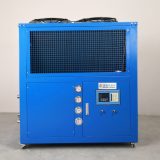When choosing a chiller for an application, it is necessary to ensure the unit adequately sized to handle maximum process loads in worst-case site conditions. However, customers may fail to plan for these conditions and make sizing decisions based on the nominal conditions that are often presented in product brochures. This could lead to an improperly sized system that will present problems in real-world operating conditions. There are several important factors that must be considered when sizing a chiller. These include maximum ambient temperature, outlet water temperature, glycol concentration and elevation above sea level.
1 Nominal conditions
Take care when reviewing technical data sheets and brochures. Cooling capacities are often stated at a nominal condition. In North America, nominal conditions are considered as 45°F leaving water temperature, 55°F inlet water temperature and 95°F Ambient temperature. Some companies, particularly those targeting the European market, may display the cooling capacities at a very different set of conditions. In Europe, nominal conditions are defined as 15°C (59°F) leaving water temperature, 20°C (68°F) inlet water temperature and 25°C (77°F) ambient temperature. So, what’s the difference? Consider that a 10.8 kW chiller rated at 59/68/77 conditions, would perform at only 7.9 kW when rated at 45/55/95 conditions. That’s approximately a 25% difference!
2 Ambient conditions
As ambient temperature increases, the cooling capacity decreases. Referencing the example above, changing from 68°F to 95°F ambient results in a 15% derating of the cooling capacity. If the cooling capacity were calculated at a higher ambient temperature of 113°F, there would be an additional 10% derating. Inversely, when ambient temperatures are lower, the conditions at the refrigeration condenser are more favorable. This allows for reduced head pressure and increased efficiency in the refrigeration circuit, thereby increasing the available cooling capacity.
It is also important to note that the ambient temperature is not necessarily referring to the outdoor temperature. It is possible to have an 80°F outdoor air temperature, but a higher indoor air temperature. Taking this to an even more localized position, it is possible to have an average indoor air temperature that is within specification but a condition at the inlet of the condenser coil sufficient to cause a fault. This is especially true if the hot exhaust air from the chiller is re-circulated.
3 Water supply temperature
The desired water supply temperature also affects the cooling capacity of the chiller. As the water temperature increases, the cooling capacity will also increase. That means if a unit is rated 10 tons at 45/55/95 conditions, and the desired water temperature for the application is 40°F, the 10-ton unit will now only have 90% of the original rated capacity. This also works to a limited extent in the opposite direction. If a 10-ton unit is operated at 70°F water outlet instead of 45°F, the capacity increases by 20%.
4 Glycol
Outdoor installations with low ambient conditions require the use of glycol for its capability to depress the freezing point of the coolant. Many industrial glycols also include a blend of corrosion and/or biological inhibitors, which make these solutions popular for indoor applications. What many people don’t realize is that the cooling capacity of the chiller is directly affected by the use of a glycol-based coolant. Due to glycol having a lower specific heat than water, a water/glycol solution is not as effective at heat transfer as plain water. While the negative effect of glycol is only about 1% capacity derating per 10% glycol solution, it is still important to factor in when sizing a chiller.
5 Altitude / elevation (above sea level)
While you won’t find a chiller installed atop Mount Everest, it is not uncommon to find a chiller installed in Denver, Colorado or Toluca, Mexico. In the aptly named Mile High City, a chiller operating at 45/55/95 conditions will be working at roughly 17% lower capacity than if it were operating at the same 45/55/95 conditions at sea level. Even higher in altitude is Toluca, Mexico. The city is just shy of 9,000 ft above sea level. At such a condition, a chiller would perform at only 72% of its nominal capacity.


Hello Sir , thank you for these important information, my question that : we have a chiller wich max cooling capacity at 35 °c 1100 kw , but our application in Bagdad Iraq at ambient temperature reach 57°c but our demands may just need max 600 kw , could this chiller can satisfy our demands ?
In general could over capacity chiller applicated in high ambient temperature?
Thank you
Hamed